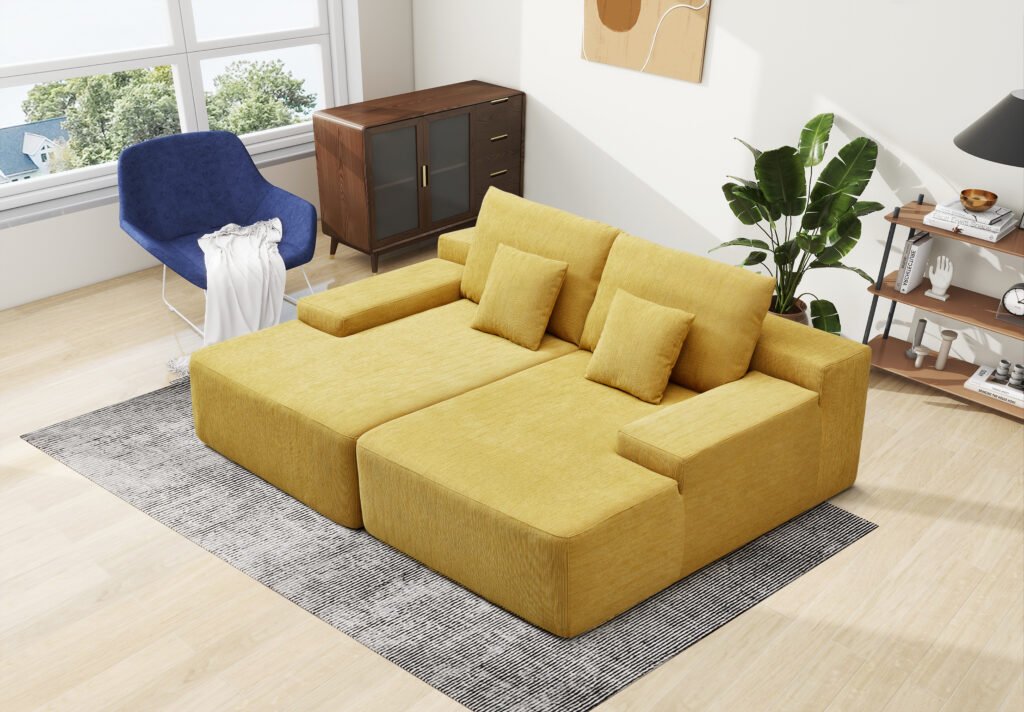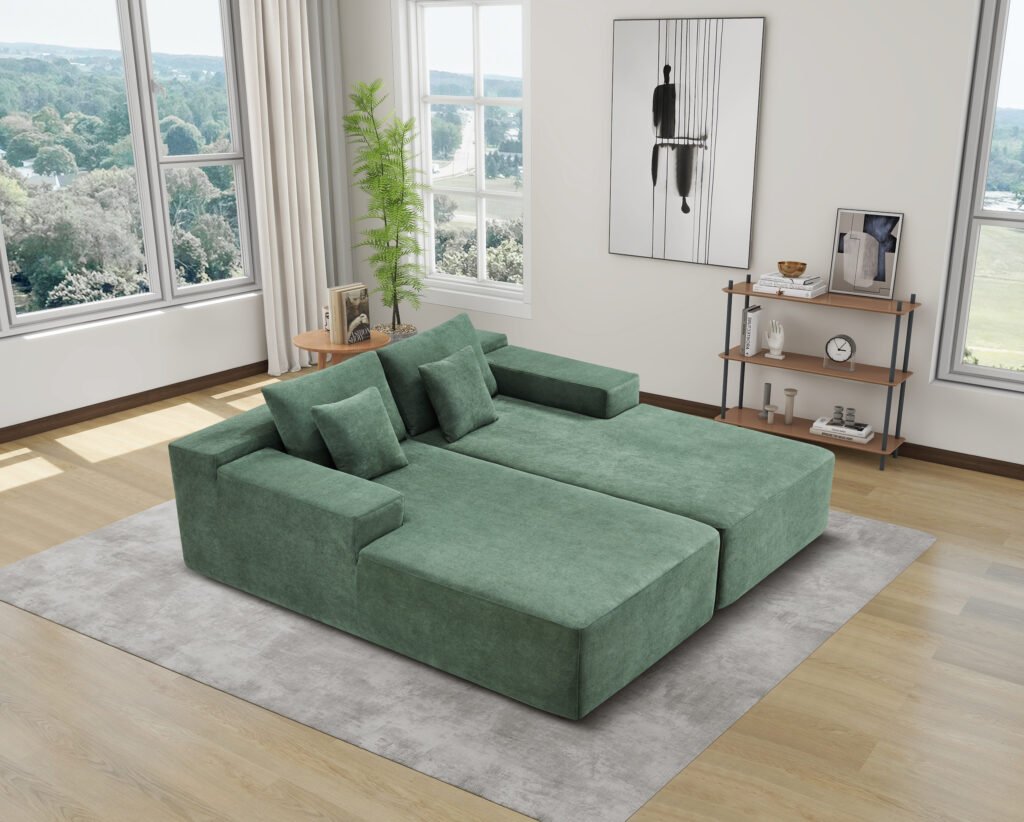Compressed sofas have revolutionized the furniture industry by allowing bulky sofas to be compacted into manageable packages for shipping and storage. Understanding the volume a packed compressed sofa occupies is essential for logistics, shipping cost calculations, warehouse management, and space planning. This article provides an in-depth look at the typical volume of compressed sofas measured in liters, factors influencing volume, and practical considerations for consumers and businesses. We also highlight how Modular-Sofas.com offers innovative modular and compressed sofas optimized for space efficiency.


What Is a Compressed Sofa?
A compressed sofa is a sofa that has been vacuum-sealed and tightly packed to reduce its volume significantly. The sofa’s cushions and sometimes frame components are compressed, rolled, or folded, then sealed in plastic packaging. This process reduces the sofa’s size to a fraction of its original volume, facilitating easier shipping and storage.
Measuring Volume: Liters, Cubic Meters, and Cubic Feet
Volume can be measured in various units:
- Liters (L): Common metric unit for volume, where 1 liter = 1,000 cubic centimeters.
- Cubic Meters (m³): Larger metric unit, where 1 m³ = 1,000 liters.
- Cubic Feet (ft³): Imperial unit, where 1 ft³ ≈ 28.3168 liters.
For furniture logistics, cubic meters and liters are frequently used to quantify space requirements.
Typical Volume Range of Packed Compressed Sofas
The volume of a compressed sofa depends on its size, design, and compression technique. Based on industry data and examples:
- Small to Medium Sofas: Typically occupy between 100 to 250 liters when compressed.
- Large Sofas and Sectionals: Can occupy 300 to 700 liters or more, depending on configuration.
- Oversized Sofas: After compression, volumes can be around 0.5 cubic meters (500 liters) or slightly higher.
For example, a typical 3-seater compressed sofa may be packed into a volume of approximately 200 to 300 liters, while a modular sectional compressed sofa might require 400 to 600 liters.
Factors Affecting Compressed Sofa Volume
| Factor | Description |
|---|---|
| Sofa Size | Larger sofas naturally occupy more compressed volume. |
| Compression Ratio | Higher compression reduces volume but may affect foam resilience. |
| Sofa Design | Modular sofas can be compressed in parts, affecting total volume. |
| Material Density | Sofas with denser foam or frames may compress less effectively. |
| Packaging Method | Vacuum sealing and rolling techniques influence final package size. |
| Cushion Type | Memory foam may compress differently than high-resilience foam. |
Volume Conversion Examples
To contextualize volume, here are some conversions:
| Volume Unit | Equivalent in Liters |
|---|---|
| 0.1 cubic meters (m³) | 100 liters |
| 0.3 cubic meters (m³) | 300 liters |
| 0.5 cubic meters (m³) | 500 liters |
| 1 cubic foot (ft³) | 28.3 liters |
Practical Implications of Compressed Sofa Volume
- Shipping Costs: Freight charges often depend on volumetric weight, calculated from package volume. Smaller volume reduces cost.
- Storage Space: Warehouses and retail stores can optimize inventory space with compressed sofas.
- Home Delivery: Easier maneuvering through doorways and staircases due to compact packaging.
- Environmental Impact: Reduced packaging volume lowers carbon footprint during transportation.


How Modular-Sofas.com Optimizes Sofa Compression
Modular-Sofas.com offers modular and compressed sofas designed to maximize space efficiency without compromising comfort:
- Advanced Compression Technology: Achieves high compression ratios for reduced volume.
- Modular Components: Allows sofas to be packed in smaller sections.
- Lightweight Materials: Use of high-density foam and durable frames that compress well.
- Custom Packaging: Tailored packaging solutions minimize wasted space.
- Customer Support: Guidance on unpacking and expanding compressed sofas for best comfort.
Table: Estimated Volume of Compressed Sofas by Size
| Sofa Type | Approximate Compressed Volume (Liters) | Approximate Compressed Volume (Cubic Meters) | Notes |
|---|---|---|---|
| Small 2-Seater | 100 - 150 | 0.1 - 0.15 | Compact, ideal for small spaces |
| Standard 3-Seater | 200 - 300 | 0.2 - 0.3 | Most common size |
| Large 4-Seater | 350 - 450 | 0.35 - 0.45 | Includes chaise or recliner |
| Modular Sectional (4-6 parts) | 400 - 700 | 0.4 - 0.7 | Packed in multiple modules |
| Oversized Sofas | 600+ | 0.6+ | High volume, less compression |
How to Estimate Volume for Your Sofa
- Measure Dimensions: Measure length, width, and height of the compressed package in centimeters.
- Calculate Volume: Multiply length × width × height to get cubic centimeters.
- Convert to Liters: Divide cubic centimeters by 1,000 to get liters.
- Compare with Manufacturer Specs: Check with the sofa provider for compression ratios.
Benefits of Knowing Compressed Sofa Volume
- Accurate Shipping Estimates: Helps calculate freight costs precisely.
- Space Planning: Enables better planning for storage or delivery vehicle loading.
- Consumer Awareness: Helps buyers understand packaging size for home handling.
- Environmental Planning: Assists companies in reducing packaging waste.


Additional Considerations
- Expansion After Unpacking: Sofas expand to full size after unpacking; volume increases accordingly.
- Compression Limits: Excessive compression can damage foam or springs.
- Packaging Weight: Volume is one factor; weight also affects shipping.
Conclusion
The volume of a packed compressed sofa typically ranges from about 100 liters for small sofas up to 700 liters or more for large modular or oversized sofas. This significant reduction in volume compared to uncompressed sofas offers numerous benefits in shipping, storage, and environmental impact.
Modular-Sofas.com leads the market by providing high-quality modular and compressed sofas with optimized packaging, ensuring customers enjoy both comfort and convenience.
Understanding the volume your compressed sofa occupies helps you plan logistics, storage, and delivery efficiently, making compressed sofas an excellent choice for modern living.